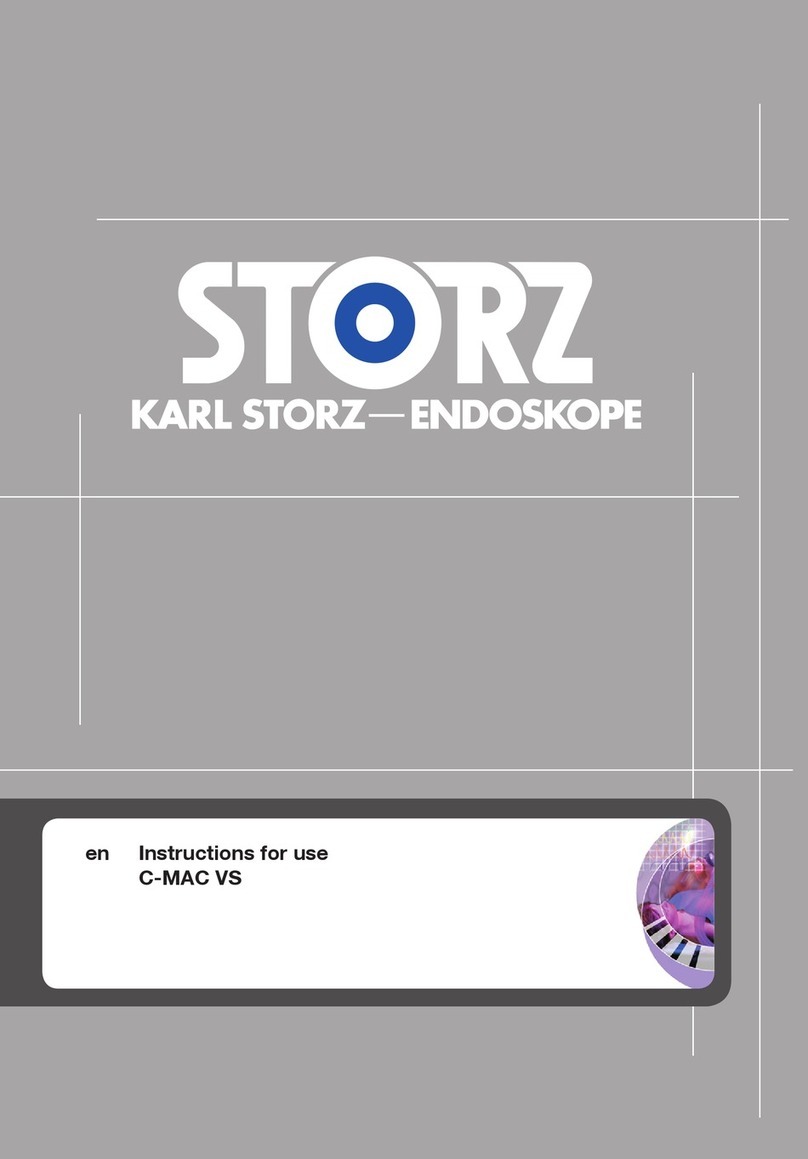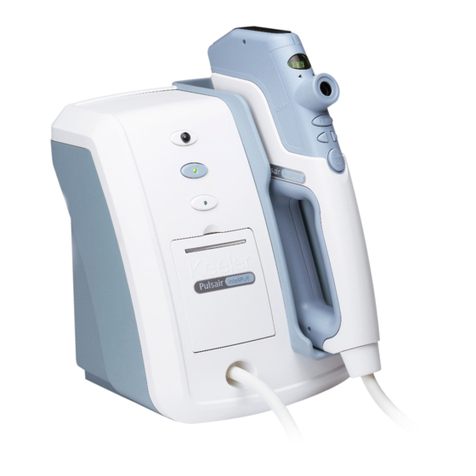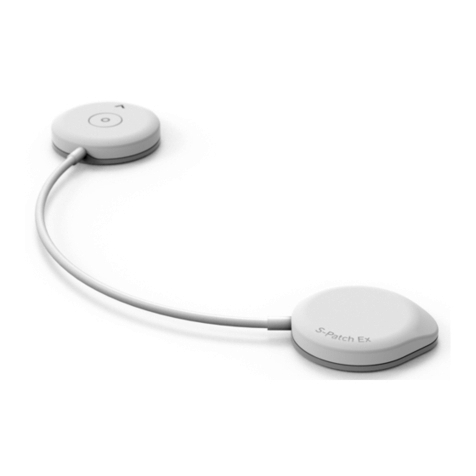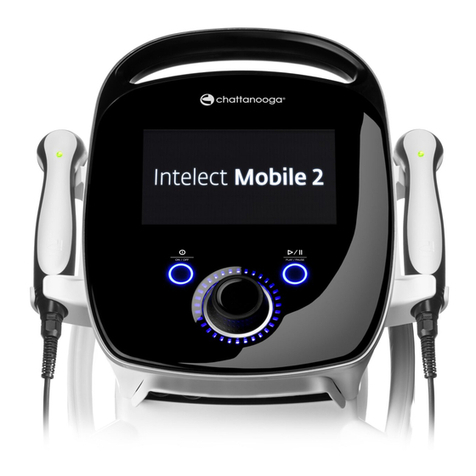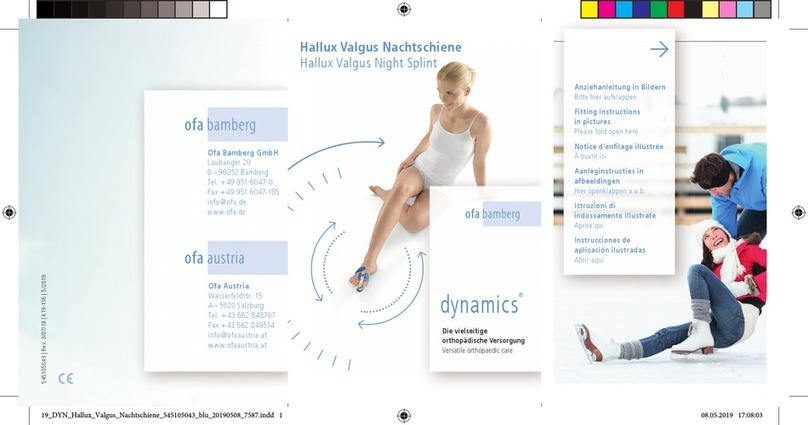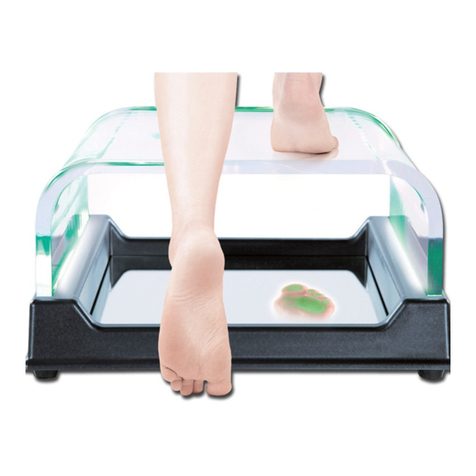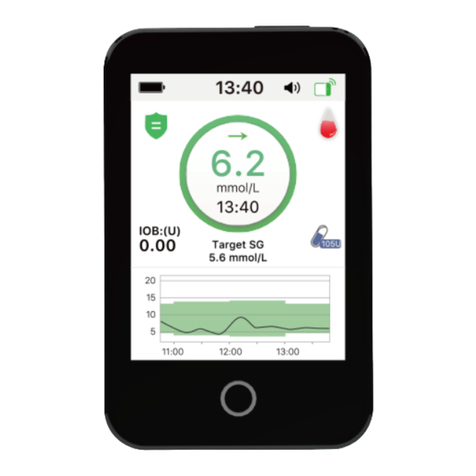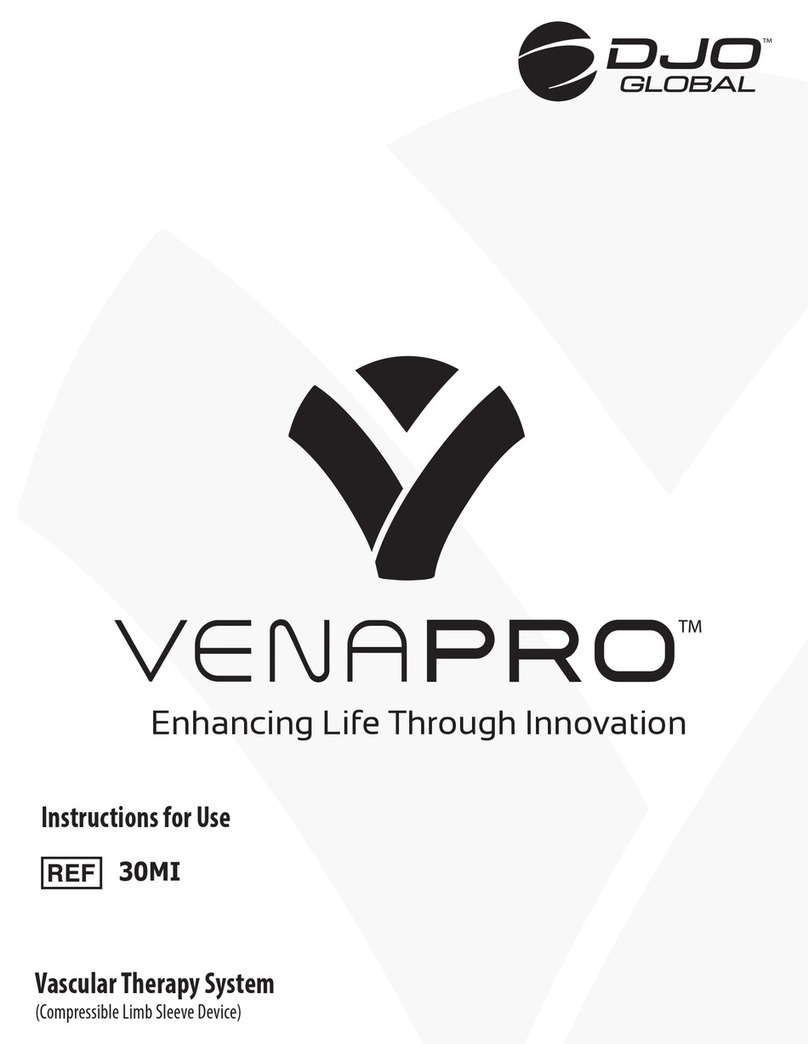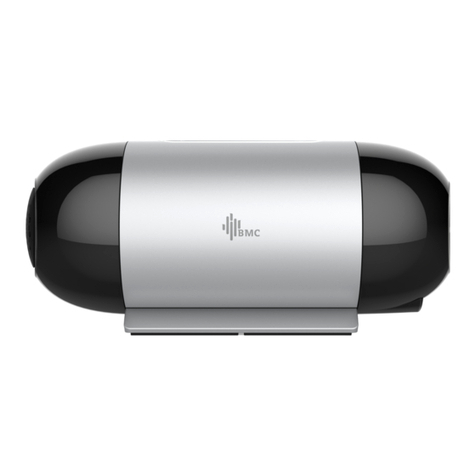Medical Feedback Technologies BEATY User manual

1
www.imbeaty.com
1
The power to save lives
CPR Feedback Device
User Manual
Manufactured by Medical Feedback Technologies Ltd.
Baruch Benaceraff 2, Rishon Lezion 7580537, Israel
European representative- Medes Limited
5 Beaumont Gate, Shenley Hill, Radlett,
Hertfordshire WD7 7AR, England, UK
Tel. +44 208123 8056 Fax +44 1923859 810
www.imbeaty.com

2
www.imbeaty.com
Important user information
BEATY is a medical device developed by Medical Feedback
Technologies LTD. and is used during real time CPR. BEATY
gives an audio feedback regarding the effectiveness of chest
compressions performed during CPR, allowing adjustments to
the recommended compression depth (for more info. See
page 4; section 1.1)
Before using BEATY, users must read and fully understand all
information and instructions provided with the device. In case
of any questions please contact our team.
It is strongly recommended that BEATY will be used by a
person familiar with basic CPR principles. (visit our website
www.imbeaty.com)
Users must follow local guidelines for CPR when using BEATY.
In case of technical issues that are not solved despite
implementation of recommended actions in page 15; section 5,
continue CPR without using the device.
Using the device in any way other than described in the user
manual provided with the device or in conjunction with other
external devices may reduce the reliability of the audible
feedback thus the effectiveness of chest compressions.

3
www.imbeaty.com
Table of contents
Important user information……………………………………………..…………………………..……….2
1. Introduction…………………………………………………….…………………….………………………..……..4
1.1 Background………………………………………………………………………………………..…..……………………...….…4
1.2 Intended use………………………………………………..……………………………………….……………………….…….5
1.3 Contraindications………………………………………………….……………………………...…..…………..….….…..5
1.4 Adverse effects…………………………………………………………………………………………..…………...….………6
1.5 BEATY description………………………….......................................................................…………….…..…6
1.6 Symbols on the device…………………………………………………………………………………………….………9
1.7 Delivered items…………………………………………………………………………………..……..…….…….…………10
2. Using BEATY…………………………………………………………………………………...………..….………10
2.1 Approaching the Victim……………………………………………………………………………..………….….…10
2.2 CPR using BEATY…………………………………………………………….………………………………..….….……..10
3. After use care………………………………………………………..…………..……………………….…....……11
3.1 Cleaning………………………………………...………………………………………………………………………….……..……11
3.2 Changing Battery……………………………………………….…………………………………………………..….…..12
3.3 Routine checks……………………………...…………………………………………………………..…………....………12
3.4 Storage……………………………………….………………………………………………………..……..…………………...….13
4. Warnings and precautions…………………………………………………………….....….………….13
5. Troubleshooting……………………………….…..……………………..…………………..…….……………15
6. Technical specifications………………………………………………………………………....………..18
7. Electromagnetic biocompatibility………………………..…………………………….………...18
8. FAQ………………………………….……….…………….……………………………………………………....………19

4
www.imbeaty.com
1. Introduction
1.1 Background
Sudden Cardiac Arrest (SCA) refers to the sudden cessation of
cardiac mechanical activity with hemodynamic collapse. 88%
of SCA cases occur at home and survival rates are less than 10%
but can be doubled or even tripled if Cardio-Pulmonary
Resuscitation (CPR) is initiated immediately by a bystander or
EMS.
Worldwide efforts are invested in educating the general
population regarding the importance of CPR. The current
American Heart Association guidelines, which are based on
extensive evidence published by the International Liaison
Committee on Resuscitation (ILCOR), emphasize the
importance of rapid identification of cardiac arrest and
initiation of high quality chest compressions. A rate of 100-120
compressions per minute and a depth of 5-6cm are
suggested. The main goal of effective chest compressions is
restoration of blood flow to the brain thus prevention of
permanent damage. For untrained bystanders, "Hands only"
CPR algorithm was developed based on similar survival rates
with either "Hands only" CPR or CPR with both chest
compressions and mouth to mouth ventilation.
Assessment of CPR quality and adherence to the CPR
guidelines was the objective of many studies and high
frequency of inadequate compressions depth compared to
guidelines has been reported. The evaluation of the exact
depth (5-6cm) is challenging, even for a trained rescuer.
BEATY is a feedback device that provides audible feedback
regarding the effectiveness of chest compressions during CPR.
With every chest compression, BEATY will tell its user whether
the performance is effective or not. The real-time given
feedback will increase sense of capability among users and the
effectiveness of chest compressions.

5
www.imbeaty.com
Since most crises happen to people close to us, BEATY was
designed to fit anywhere within reach. It can be stored in first
aid kits, glove compartment or can even be used as a key
chain. It's extremely easy for use and very affordable.
We believe in simplicity. We believe in accessibility.
We believe in saving lives.
1.2 Intended use
BEATY is to be used during CPR in cases of cardiac arrest,
allowing the user to perform effective chest compressions as
suggested in the current AHA guidelines. BEATY is placed
between rescuer’s palm and victim’s chest while performing
chest compressions. BEATY gives an audible feedback with
each adequate chest compression, reaching a depth of 5 cm,
thus increasing victim's chances of survival as well as the user's
sense of capability.
1.3 Contraindications
BEATY is not to be used in the following cases:
-Children- BEATY is to be used only on victims 8 years old
and above
-If there is no indication for chest compressions or chest
compressions are unlikely to help the victim

6
www.imbeaty.com
1.4 Adverse effects
Various rates of skeletal and non-skeletal injuries due to
effective chest compressions were reported in several studies
Nevertheless, it has been concluded that the injuries were in
by and large non-fatal. It is important to remember that
deeper compressions increase survival and that potential
injuries are an acceptable alternative for death due to cardiac
arrest. NOTE! BEATY is not the resuscitator. It is only there to
give an audio feedback during real time CPR that is performed
according to guidelines.
1.5 BEATY description
Restoring effective blood flow to the brain is achieved by
compressing the victim's chest to a depth of 5 cm. BEATY
provides audible feedback regarding the correct depth. BEATY
was designed to fit anywhere within reach in cases of medical
emergencies. BEATY can be stored easily in first aid kits, glove
compartments or may be used as a key chain.
The device has no software.
External View
2
1
3
3
4
5
6
6
6

7
www.imbeaty.com
1. Upper concave soft pad (TPU- ELASTOLLAN Soft 45A ESD)
designed to fit perfectly to your palm
2. Schematic drawing describing correct placement of BEATY
3. Hard lid made of high-quality materials (MACROLON 2407
POLYCARBONATE) capable of enduring high forces applied on
the device when performing chest compressions
4. Sound output
5. Lower soft pad (TPU- ELASTOLLAN Soft 45A ESD) that
comes in contact with victim's chest
6. Keychain hole made for easy attachment of the device
allowing it to be within reach in case of medical crises
Internal View
1. PCB containing BEATY'S electrical components
2. 3V lithium battery
3. Buzzer
4. Sensor
Silicone adapter
A silicone adapter is provided with each product.
The silicone adapter adds protection to your device. In
addition, due to a larger surface area (7.2cm diameter) it
increases user’s comfort when prolonged CPR is required
(rural areas, medical teams etc.).
NOTE! The silicone adapter is not mandatory for the proper
utilization of BEATY and does not increase its effectiveness. The
adapter can be used at user’s choice and preference.
1
2
3
4

8
www.imbeaty.com
Using the silicone adapter
When opening the package, you should find BEATY correctly
inserted into the silicone adapter- BEATY’s bottom part (silicon
cushion with embedded symbols) is seen on the open part of
the silicon adapter. This is the component that comes in direct
contact with patient’s chest (See fig. 1 next page).
You can use BEATY with or without the adapter.
Extracting BEATY from the silicone adapter-
1. Hold the silicon adapter using both hands with upper
part facing up.
2. Apply pressure on the middle of the silicon adapter,
using both thumbs. The device should easily come
out from the other side (See fig. 2 next page).
3. Use the device according to instructions (Page 10;
Section 2)
Inserting BEATY into the silicone adapter-
1. Hold the silicon adapter with hollow part facing up.
2. Align BEATY according to the silicon adapter using
buzzer output and keychain holes as reference points
(See arrows in fig. 1 next page). NOTE that BEATY’s
bottom part (silicon cushion with embedded symbols)
should also face upwards.
3. Use the device in the same often as when using it
without the silicone adapter.
*fig. 3 next page describes correct and incorrect BEATY
position within the silicone adapter.

9
www.imbeaty.com
1.6 Symbols on the device
CE Compliant
Restriction of
Hazardous
Substances Directive
Compliant (materials
and components)
Waste Electrical
and Electronic
Equipment
Directive
Compliant
Refer to User
Instruction
Guide
Handle with care
Manufacturer
Manufacturing date
Type BF applied
part
IP22
Ingress property- Degree of
protection provided by
enclosure per IEC 60529
Figure 2
Figure 1
Bottom part
Upper part
Figure 3

10
www.imbeaty.com
1.7 Delivered items
Each delivered product contains the following items:
1. BEATY device in your preferred color
2. Silicon Adapter
3. 3V lithium battery installed within the device
4. User manual
1) 2) 3) 4)
2. Using Beaty
The use of BEATY is subject to the routine indications and
guidelines for CPR. BEATY is there to give you an audible
feedback regarding the effectiveness of routinely performed
chest compressions.
2.1 Approaching the Victim
•Secure your area- move the victim and yourself away from
hazardous factors (i.e. - road, electricity etc.)
•Confirm cardiac arrest- check for consciousness and
breathing
•Call for help
2.2 If CPR is indicated
Start chest compressions according to CPR guidelines
•Place BEATY in the middle of the victim's chest as shown
in the sketch on top of the device. It is recommended not
to use the device above clothes.

11
www.imbeaty.com
•Place your palms above the device. The base of your
palms should fit perfectly to a concave soft pad on top of
the device.
•Start compressing- with each effective chest
compression, BEATY will produce a sound. If no sound is
heard follow instructions in section 6. Principles for
effective chest compressions:
oPerpendicular alignment to the victim
oLocked elbows
oChest compressions rate should be 120/min.
oFull chest recoil- after BEATY produces a sound, it is
crucial to allow full chest recoil before next
compression
*If AED (Automatic External Defibrillator) is within reach use it
according to instructions.
3. After use care/maintenance
The device is categorized as ingress/international IP22
according to IEC 60529
3.1 Cleaning
Use alcohol pad or wet wipe to clean the device.
When cleaning, focus on the lower soft pad that
comes in contact with Victim’s chest. Do not
immerse in water or disinfectant solution as
liquids of any type can damage the internal
mechanism of the device.

12
www.imbeaty.com
3.2 Change of battery
When changing battery, only UL approved batteries are
allowed (list of UL approved batteries is described below)
1. Remove upper soft pad
2. Unscrew upper screw
3. Open the device using rotation movement
4. Change battery
1) 2)
List of possible UL approved 3v lithium coin cell batteries*
GP CR2032
Energizer CR2032
Panasonic CR2032
Sony CR2032
*The list provided above is NOT a full list of UL approved
batteries. The list contains only several options. For UL
verification for your battery, visit:
http://database.ul.com/cgibin/XYV/template/LISEXT/1FRAME/index.html?utm_source=b
utton&utm_medium=ulcom&utm_campaign=ulwebsite_ocd_referral
3.3 Routine checks
It is recommended to check the device by pressing the device
against any stationary object and producing a sound. Battery
life time is 3 years in standby mode or 15 hours of use. We
recommend changing the device every 5 years.

13
www.imbeaty.com
3.4 Storage
Avoid exposing the device to excessive moist or dirt.
4. Warnings and precautions
4.1 General safety precautions
CAUTION- APPROVED ACCESSORIES
Use only UL approved batteries. If you use other
batteries, you can cause permanent damage to Beaty.
This also voids the warranty,
CAUTION- LIQUIDS
Do not immerse Beaty in liquids as direct liquids can
damage the device
4.2 Operation warnings and precautions
CAUTION- ROUTINE CHECKS AND AFTER USE CARE
It is important to follow instructions regarding routine
checks and after use care (provided within this user
manual).
WARNING - INCORRECT POSITION OVER CHEST
If Beaty is not in the correct position in relation to the
sternum, there is a possibility that it does not function
properly. Place the device in the middle of victim’s
chest as shown on the sketch on top of the device.

14
www.imbeaty.com
WARNING - UNSATISFACTORY OPERATION
If the use of Beaty delays or interrupts with effective
CPR. Continue CPR without the device.
WARNING - SOUND
If no sound is heard despite taking actions as
recommended in troubleshooting section, continue
CPR without the device.
WARNING- EXTERNAL DAMAGE
If external damage is seen, do not use Beaty as it can
result in user and victim injury as well as malfunction
of the device.
WARNING- DO NOT OPEN THE DEVICE IF
UNESSECERY
Open the device only for battery replacement. You
should follow the exact instructions provided within
this user manual. Do not touch any other electrical
component as it can damage the device.

15
www.imbeaty.com
5. Troubleshooting
Users must be familiar with the possible technical problems
and their solution. For any questions please contact our team.
Arising
problem
Possible
cause
Solution
Prevention
No sound is
heard before
use/ sound is
not loud
enough
-Not enough
pressure
applied
-Battery ran
out
-Audio inlet Is
covered by
user’s palm
-Broken
device
1. Make sure
audio inlet is
not covered by
hand
2. Make sure
compressing
perpendicularly
to victim’s chest
3. Push deeper by
applying more
pressure
4. Change battery
as instructed in
page 12; section
3.2
5. Contact our
customer
service
1. Check
routinely for
propriety (see
page 12;
section 3.3)
2. Follow ‘after
use care’
instructions
(page 11;
section 3)

16
www.imbeaty.com
No sound is
heard during
CPR use/
sound is not
loud enough
-Loud
environment
-Not enough
pressure
applied
-Battery ran
out
-Audio inlet Is
covered
-Broken
device
1. Make sure
audio inlet is
not covered by
hand
2. Make sure
compressing
perpendicularly
to victim’s chest
3. Push deeper by
applying more
pressure
4. Change battery
as instructed in
page 12; section
3.2
5. Contact our
customer
service
6. If no solution
found –remove
BEATY and start
compressing
without the
device
1. Check
routinely for
propriety (see
page 12;
section 3.3)
2. Follow ‘after
use care’
instructions
(page 11;
section 3)
Continuous
sound during
CPR
Improper
chest recoil
1. With each
sound
produced by
the device.
Allow victim's
chest to fully
recoil
2. As chest is fully
recoiled, repeat
chest
compression
3. Note that rate
should be 100-
120/min

17
www.imbeaty.com
External
damage to
the device
-Improper
storage
-Dropping the
device
If damage prevents
compressing
effectively d/t user
discomfort or in
case no sound is
heard despite
actions in section 2
in this table-
continue CPR w/o
using BEATY
1. Check
routinely for
propriety (see
page 12;
section 3.3)
2. Follow storage
and after ‘use
care’
instructions
(page 11;
section 3)
Discomfort in
user’s palm
Improper
location of
palm over the
device
1. Change palms
position over
the device.
BEATY has an
upper concave
soft pad that
should fit the
base of your
palms. NOTE!
Do not change
position of the
device
regarding
victim’s chest
2. If discomfort
prevents
effective chest
compressions.
Continue CPR
w/o BEATY

18
www.imbeaty.com
6. Technical specifications
7. Electromagnetic Compatibility
Test
Standard
Class/Severity
level
Test
result
Emission (IEC 60601-1-2 section 7)
Radiated emission
Freq. range: 30-1000
MHz
Sec. 7.1 &
CISPR 11
Group 1 Class B
Complies
Immunity (IEC 60601-1-2 section 8)
Immunity from
Electrostatic discharge
(ESD)
IES 61000-4-2
8 kV contact
discharges &
15 kV air
discharges
Complies
Immunity from
radiated
electromagnetic fields
IES 61000-4-3
10.0 V/m
80 MHz ÷ 2.5 GHz,
80% AM, 1kHz
Complies
Item
Specification
Technical Data
Power
Requirements
Rated input voltage
3V lithium coin battery
Dimensions
Width*length*height(cm)
5*5*2.4(cm)
Weight
Total device weight
(battery included)
34g
Operating
environment
Ambient temperatures
Relative Humidity
Atmospheric Pressure
Between 32° and 102.2°
F (0° and 39° C) and in
normal conditions
10% to 90% RH
Up to 2000m above sea
level (700hpa)
Ingress
protection
IP22
Resistant to solid
objects greater than
12.5mm such as finger
and vertically falling
drops over an actuator
tilted 15O

19
www.imbeaty.com
8. FAQ
Q: When should I start performing CPR?
A: If victim is unconscious (does not respond to shaking or
calling his name), look for breathing or only gasps. If not
breathing, call for help and start compressing his chest to a
depth of 5cm. Beaty will help you perform effective chest
compressions.
Q: What does CPR do?
A: When the heart stops from beating, blood flow to the
brain and vital organs ceases. Within 4 minutes the
damage to the brain is irreversible. Effective CPR allows
blood flow to the brain, preventing permanent damage.
CPR can triple chances of survival.
Q: When should I use Beaty?
A: Beaty should be used in every case where CPR is
indicated. As gauging the exact compression depth is
almost impossible, Beaty will help you by providing real-
time audible feedback when applying adequate force
during chest compressions.
Q: Do I have to be well trained before using Beaty?
A: Beaty was designed to be very intuitive so any individual
is able to use it in case of a medical emergency. A sketch
upon the device will guide you where to place it. After
locating the device between your palms and victim’s
chest- start compressing until audio feedback is achieved.
The sound provided by the device indicates you are
compressing effectively.

20
www.imbeaty.com
Q: What about ventilation? Is it unnecessary?
A: Based on extensive research, the current CPR guidelines
put an emphasis on effective chest compressions. If you
are trained and feel safe with ventilating the victim,
combining chest compressions and ventilation is
recommended at a rate of 30 compressions followed by 2
rescue breaths. For untrained rescuers or in case you don’t
feel safe or comfortable with ventilating the victim - chest
compression only CPR is recommended (based on similar
survival rates with either "Hands only" CPR or CPR with
both chest compressions and mouth to mouth ventilation)
Q: What is the recommended compression rate?
A: The recommended compression rate is 100-120/min. This
can be estimated by following the rhythm of the song
“Stayin’ alive/Bee Gees”.
It is important to pay attention that pushing fast does not
result in shallower depth.
Q: How about other parameters not provided by the
device (rate, chest recoil etc.)?
A: Effective CPR is composed from several parameters and
not only compression depth. It is important to understand
though, that medical emergencies are very stressful
(especially when it comes to our loved ones). Too much
information provided by a feedback device, during real
time CPR can confuse lay rescuers and result in ineffective
CPR. The major gap nowadays is in estimating
compression depth (rate can be estimated by using other
means) and many studies show suboptimal compression
depth, even among professionals.
Beaty provides an effective, simple and affordable solution
and was confirmed in experiments for effectiveness and
Table of contents
Popular Medical Equipment manuals by other brands
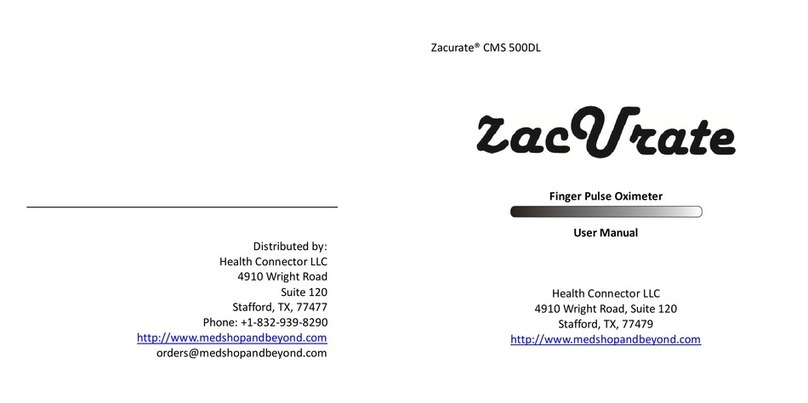
Health Connector
Health Connector zacurate CMS 500DL user manual
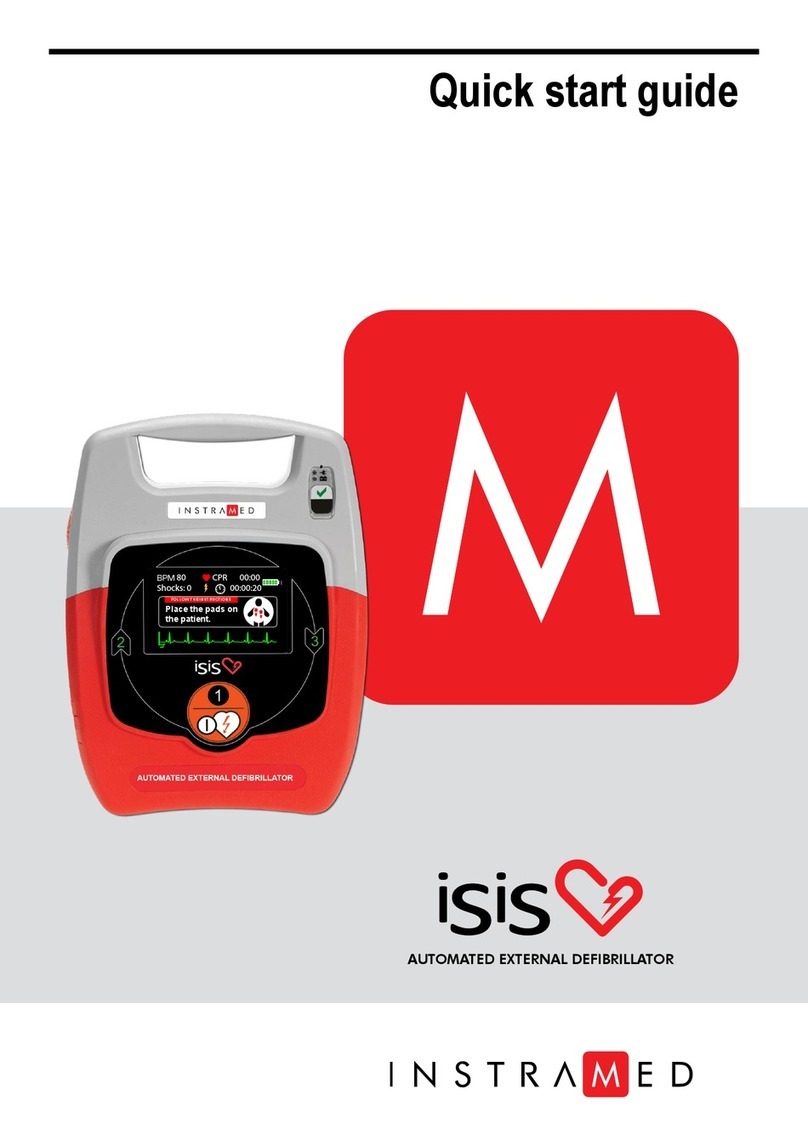
Instramed
Instramed Isis quick start guide
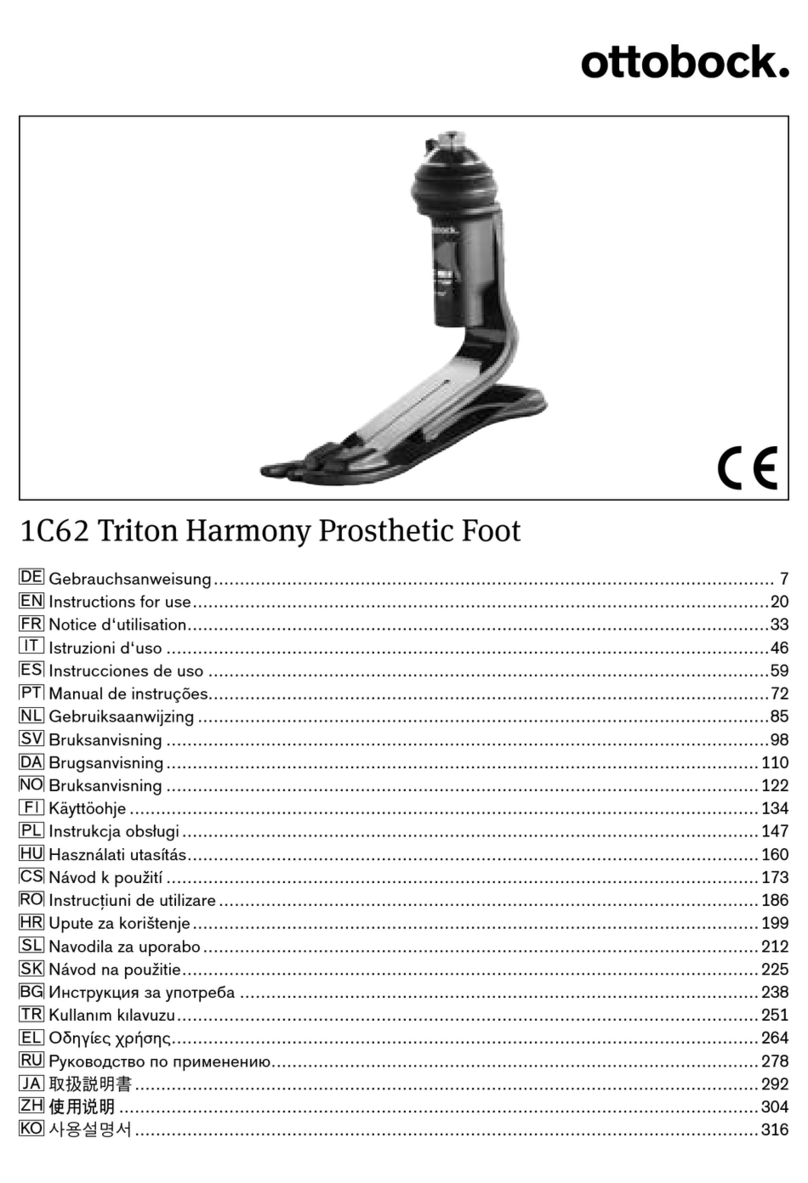
Otto Bock
Otto Bock 1C62 Triton Harmony Instructions for use
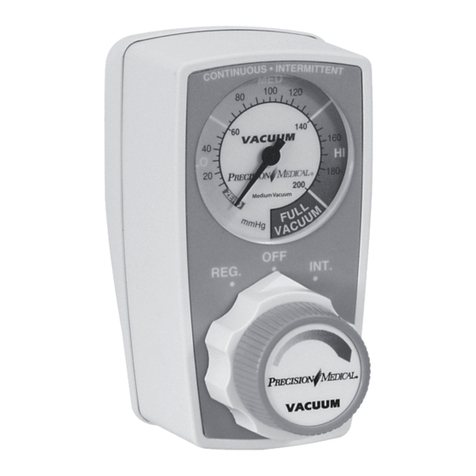
Precision Medical
Precision Medical PM3300 user manual
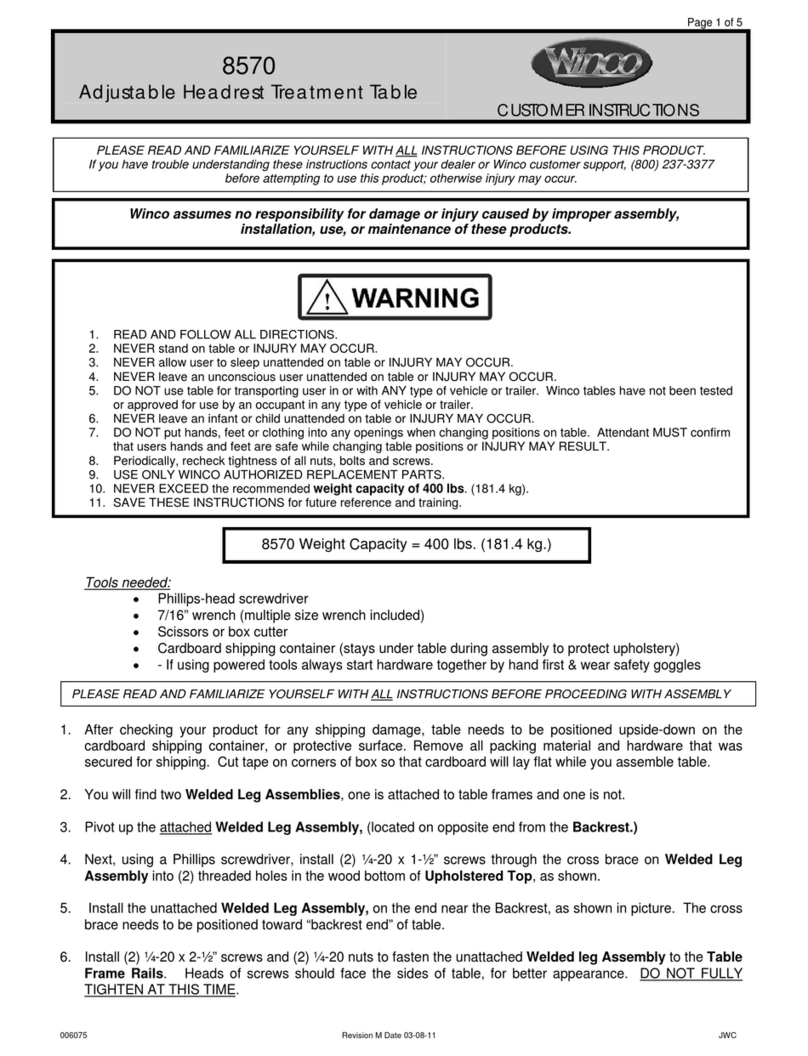
Winco
Winco 8570 CUSTOMER INSTRUCTIONS

Nasco
Nasco Life/form LF01069U instruction manual
